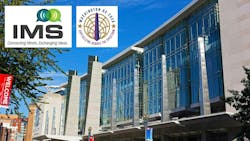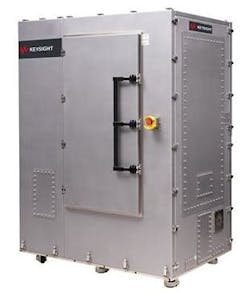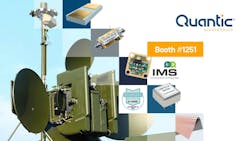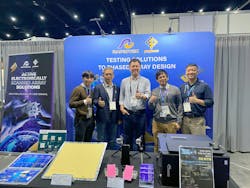What You Missed at IMS 2024 (Part 1)
Browse our complete IMS 2024 coverage.
Here, we offer roundups of coverage from the 2024 edition of the International Microwave Symposium (IMS) in Washington, D.C. This is Part 1 of 4.
Reactel (Booth 814) offers its full line of application-specific RF, microwave and mmWave filters, multiplexers, and multifunction assemblies, with an emphasis on devices at up to 67 GHz. The AS9100-accredited vendor’s devices are well-known among prime military contractors such as Lockheed Martin, L3Harris Technologies, BAE Systems, and Northrop Grumman in ground, airborne, and space applications.
At the booth (or online), grab the company’s new short-form catalog of bandpass, lowpass, highpass, and notch filters in various topologies including tubular, LC, cavity, waveguide, ceramic, and suspended substrate.
Analog Devices (Booth 1239) will have its typically dominant presence at IMS, both on the show floor and in the technical sessions. The booth will be bursting with demos of products for the aerospace/defense, instrumentation, power, and cloud/communications markets. One that looks particularly interesting is an 8T8R Open RAN radio-unit reference design. Aimed at helping reduce design times, the Kerberos reference design is for O-RAN-compliant split 7.2A applications.
On the aerospace/defense side, look for a selection of demos of ADI’s Apollo MxFE, a mixed-signal front-end that was the talk of IMS 2023 in San Diego. One year hence, ADI is primed to show off the device’s depth and breadth of application versatility. It offers sampling rates of up to 40 Gsamples/s.
Nuvotronics (Booth 427) is at IMS with its line of mmWave/RF systems for high-frequency applications. In the booth, you can see demos of:
- Filters delivering narrowband machined filter performance or wideband performance using the company’s PolyStrata suspended substrate technology. The easy-to-integrate devices come in an SMT form factor with a 100X smaller volume than conventional filters,
- Combiners for solid-state power amplifiers in ultra-broadband and mmWave applications; these devices come in a connectorized fixture that is 100X smaller at 1% of the weight compared to conventional waveguide combiners, and
- Couplers that provide size, weight, and performance advantages in SMT form factors with 6X to 10X size reductions.
Jariet Technologies (Booth 2326) is expanding its flagship Electra-MA family of data-converter transceivers. The expanded portfolio addresses the needs of radar, satellite communications, test equipment, and quantum computing with offerings from 100 MHz to 36 GHz and increased port density. The Electra platform provides direct RF sampling from VHF to Ka-band at ADC/DAC sample rates up to 64 Gsamples/s.
The devices’ 36-GHz bandwidth enables software-defined radio (SDR) applications at double the frequency previously possible and with signal instantaneous bandwidth (IBW) up to 6.4 GHz per converter. Electra is said to more than triple the clock rate of the nearest competitor’s ADC, and more than double the nearest DAC. The 10-bit, 64-Gsample/s ADCs deliver 10 dB better noise spectral density (NSD) and 17 dB better noise figure (NF) at 9.5 GHz than the best 14-bit ADCs.
Keysight Technologies (Booth 721) plans several demonstrations of its capabilities in test methodologies and EDA tools:
Wideband active load-pull: Showcases Keysight’s newly introduced wideband active load-pull (WALP) capability using a dual-channel VXG-C vector source and a PNA-X network analyzer to demonstrate the error-vector-magnitude performance of a power amplifier when presented with arbitrary frequency-dependent load impedances created without an impedance tuner.
AI/ML-enabled EDA: Demonstrates Keysight’s ADS 2025, which offers 3D Circuit-EM-Thermal multi-physics co-design, high-performance automation enabling AI/ML and robust design validation for RF and millimeter wave, and provides support for wideband power-amplifier design techniques, including nonlinear load pull.
Phased-array antenna test: Showcases Keysight’s phased-array control and calibration test solution inside the Vertical Compact Antenna Test Range (CATR), which accommodates a wide variety of phased-array antenna performance verification tests including fast gain and phase calibration, effective isotropic radiated power (EIRP), antenna radiation pattern, antenna gain-to-noise-temperature (G/T), modulation distortion, and radio frequency to direct digital measurements.
Signal-source characterization: Demonstrates how to perform sub-THz phase-noise measurements with Keysight’s new E5058A 54-GHz SSA-X signal source analyzer and an E5051AW phase-noise measurement downconverter for 6G applications and microwave amplifier residual phase-noise and AM-noise measurements.
IQ data characterization: Highlights how Keysight’s vector signal analysis software uses a new feature to precisely characterize a homodyne (IQ) system by characterizing and digitally correcting the frequency-dependent dispersion and imbalance of a Marki IQ mixer.
Quantic Electronics (Booth 1251) will be at the show with its bevy of brands spanning EMI/RF filters, frequency-control devices, magnetics, passive waveguides, coaxial components, passives, and much more. Intended for mission-critical systems, Quantic’s off-the-shelf and custom products bring benefits in terms of speed, power handling, and density.
In the booth, the company will demonstrate the performance under vibration of its ultra-low phase-noise frequency-control and timing components. Visitors can also try Quantic X-Microwave’s layout tool for signal chains built with its X-MWblock elements, as well as analyze measured data for the devices.
Rapidtek Technologies (Booth 2249), which designs active electric-scan antennas (AESAs), will conduct live joint demonstrations of its next-generation test solution. The demo involves generating a sub-6G baseband signal using Amarisoft’s AMARI Callbox and the jointly developed up-downconverter (UDC) system, which enables the generation of mmWave communication test frequency bands ranging from 6 to 48 GHz. It supports testing in frequency bands such as Ku-band, Ka-band, and n257~n262 while offering advanced signaling control. The solution has completed numerous 3GPP standard communication test verifications, including Wi-Fi 6E/7, 5G FR2, and B5G.
In addition, Rapidtek will display its AESA designs and RF testing solutions, including phased-array antennas, communication payloads, and up-downconverters. These solutions offer reliable and high-performance connectivity for a wide range of low-Earth-orbit (LEO) satellite applications.
Rapidtek will also showcase passive solutions and products in collaboration with its strategic partner, Unictron Technologies Corp. Unictron Technologies offers antennas, antenna modules, and piezoelectric ceramic elements, widely used in various applications such as automobile parking sensors, weaving machine actuators, ultrasonic nebulizers, ultrasonic sensors, and a wide range of ultrasonic transducers.
TransEON (Booth 2343), a Canadian stealth-mode startup, has developed a new MOSFET-based GaN-on-SiC foundry process that enables fabrication of cutting-edge transistors and MMICs with significant benefits over existing GaN HEMT technology. Key advantages include up to 4X higher operating voltage and RF power density at frequencies ranging from HF up to W-band.
The process includes standard MMIC features to provide turnkey compatibility with existing GaN processes, including through-substrate vias, integrated passives, and Au-plated microstrip on thinned SiC. Other advantages of the devices include full process customization, design and NRE services, ITAR and ITAR-free compatibility, as well as multi-project wafer access.
Altum RF (Booth 510) will showcase its lineup of broadband Q/V/E-band low-noise and medium-power amplifiers, which are intended for next-generation, high-capacity networks. Applications include test and measurement, SATCOM, sensing applications, and point-to-point wireless communication for 5G and 6G networks. These high-frequency amplifiers use advanced GaAs technology, which delivers a low noise figure and linear amplification with less signal distortion at medium power.






